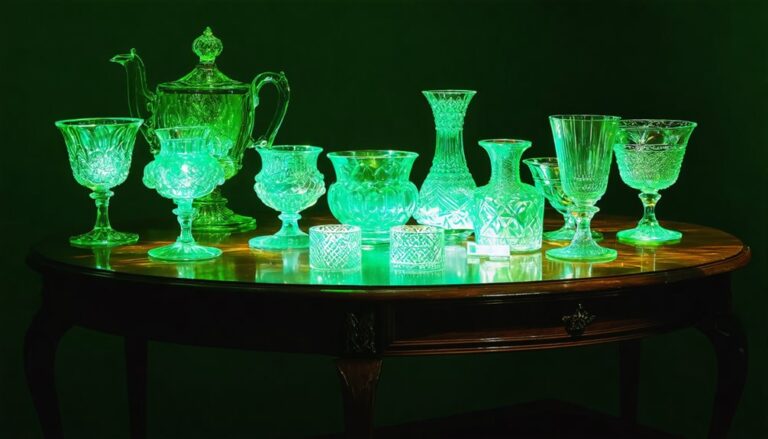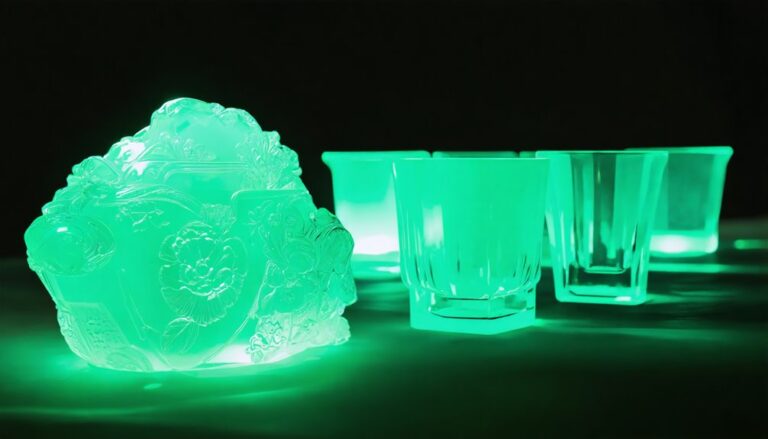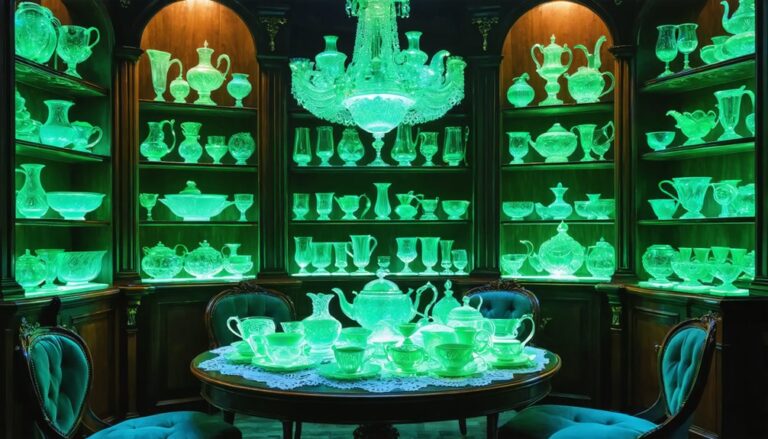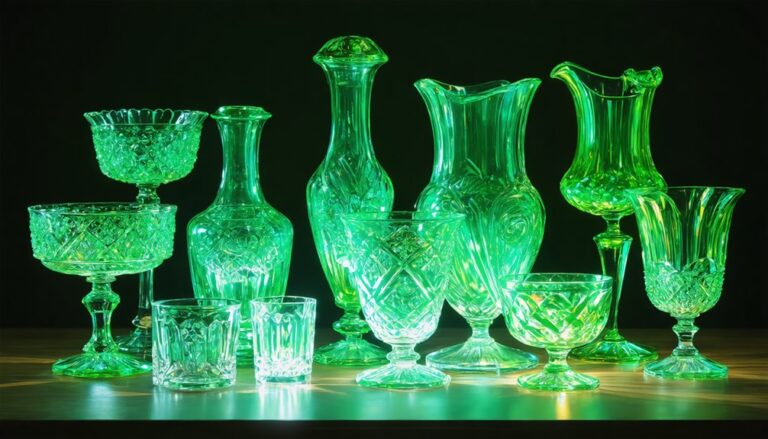The Science Behind the Luminescence of Uranium Glass
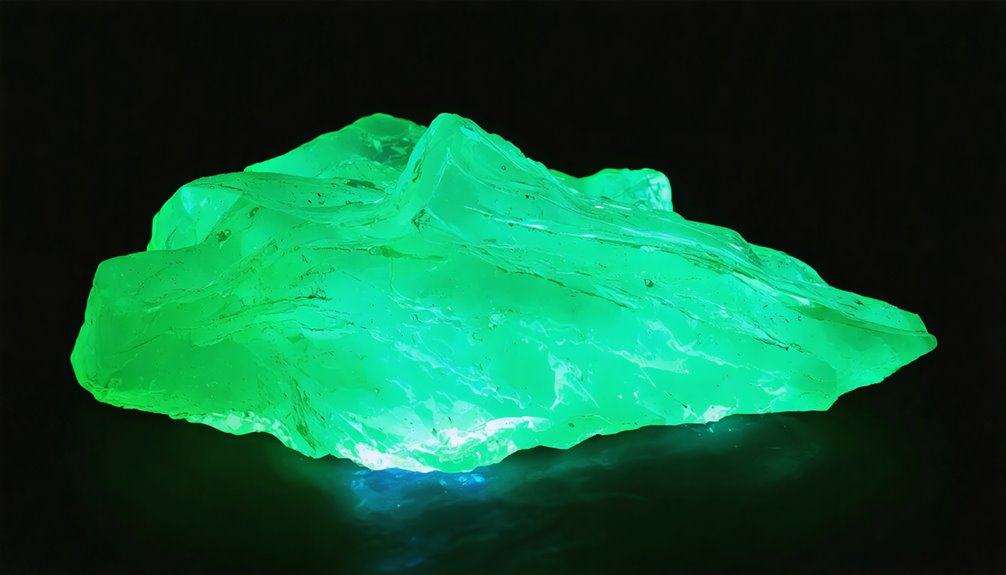
Uranium glass has a rich history that dates back to the early 19th century. Initially, it was created as a novelty item. Glassmakers discovered that adding uranium oxide to glass produced a striking green or yellow hue. This unique color quickly caught the attention of collectors and decorators.
In the late 1800s, uranium glass became popular for making tableware. People enjoyed its distinctive glow under ultraviolet light. It was often used in vases, dishes, and other decorative pieces. The bright fluorescence added a magical touch to everyday items.
During the early 20th century, uranium glass was also used in the production of industrial glass. Manufacturers valued its durability and aesthetic appeal. However, the use of uranium in glass declined after World War II. Concerns about radioactivity led to strict regulations.
Today, collectors cherish uranium glass for its historical significance and unique properties. It serves as a reminder of a time when science and art intertwined to create beautiful objects. The glow of uranium glass continues to captivate those who appreciate its beauty and history.
Key Takeaways
Uranium glass, known for its striking fluorescent yellow-green glow, has a fascinating history. Early in the 19th century, glassmakers discovered that adding uranium oxide to glass could create a vivid luminescent effect. This addition, typically ranging from 1% to 30%, significantly increased the brightness of the glass.
The process works because uranium atoms absorb ultraviolet (UV) light. When these atoms gain energy, their electrons become excited. They eventually release this energy as visible light when they return to their normal state. This unique property made uranium glass quite popular for decorative items and tableware, especially during the Victorian era.
The presence of other metals in the glass can change its color and fluorescence. For example, adding iron or manganese alters the hues, resulting in a variety of beautiful shades. Collectors often seek out these variations, as each piece tells a different story.
Despite containing radioactive uranium, handling uranium glass is generally safe. The radiation primarily consists of alpha particles, which cannot penetrate human skin. This safety factor allowed people to use and display these vibrant pieces without concern.
As time passed, the fascination with uranium glass waned. However, its historical significance remains. Today, collectors and enthusiasts appreciate it not only for its beauty but also for the unique scientific principles behind its luminescence.
History and Origins of Uranium Glass
Uranium glass has an interesting history that goes back to the 1830s, long before we thought about nuclear energy. Glassmakers found that adding uranium oxide made beautiful, glowing colors in their creations. The element uranium was first discovered by chemist Martin Heinrich Klaproth in 1789. However, it took many years for people to realize how it could be used in glassmaking.
During the late 1800s and early 1900s, uranium glass became very popular. People were fascinated by its unique, fluorescent glow, which connected to the exciting discoveries about radioactivity happening at the time. Notable manufacturers like Powell Whitefriars, Adams & Company, and Steuben Glass produced a variety of stunning pieces.
In the late 1800s, uranium glass captivated people with its distinctive fluorescent glow, symbolizing an era fascinated by radioactivity and scientific discovery.
Production of uranium glass faced a pause in the U.S. during World War II. After the war, in 1959, it made a comeback with the use of depleted uranium. This revival allowed artisans to once again create the captivating glassware that had once amazed many.
The early uses of uranium glass highlight how science and art combined to produce something truly remarkable.
Chemical Composition and Properties
Let’s dive into the fascinating history of uranium glass and its early uses. Uranium glass, also known as Vaseline glass, has roots that trace back to the early 19th century. Initially, it was created to enhance the appearance of glassware. The vibrant glow of uranium glass captivated many, leading to its popularity in decorative items.
Uranium oxide was added to glass to achieve a range of colors and effects. This unique blend not only created stunning pieces but also had a practical aspect. The glass was used in household items like bowls and vases, often sought after for its aesthetic appeal.
The glow from uranium glass isn’t just visually striking; it also has an interesting scientific background. When exposed to ultraviolet light, the uranium atoms within the glass absorb energy and emit a visible glow. This property made uranium glass a favorite among collectors.
During the late 1800s and early 1900s, uranium glass became widely produced in Europe and America. It was often used in art glass and tableware, captivating the public with its unusual luminescence.
However, as awareness of radioactivity grew, the use of uranium in glassware became more scrutinized. Despite its decline in mainstream production, uranium glass remains a collectible item today.
Enthusiasts appreciate its historical significance and unique characteristics. The blend of beauty and science in uranium glass continues to intrigue people, making it a lasting part of glass history.
Uranium’s Role in Glass Coloration
Uranium glass, often called Vaseline glass, has a fascinating history. It gained popularity in the 19th century. People admired its unique colors and bright fluorescence. The glassmakers used uranium oxide, such as diuranate or uranium dioxide, in their glass mixtures. This practice started in the 1830s.
The amount of uranium oxide added determined the glass’s color. Typically, glassmakers used between 2% and 30% uranium by weight. With higher amounts, the glass turned deeper shades of green or yellow. The vibrant hues and glowing effects made these pieces highly sought after.
The uranium content, ranging from 2% to 30%, determined uranium glass’s captivating glow and vibrant shades of green or yellow.
Other metal ions in the glass mixture also played a role in the final color. This means that the shade of uranium glass could vary significantly. Glassmakers were skilled in balancing these ingredients to create stunning designs.
Uranium glass wasn’t only decorative but had practical uses too. Some people believed it had beneficial properties. It was often used for kitchenware and decorative items. The combination of beauty and perceived value made uranium glass a staple in many households.
In summary, uranium glass reflects a blend of artistry and early scientific curiosity. The use of uranium oxide in glassmaking opened new possibilities for color and design.
Today, collectors cherish these pieces for their historical significance and unique appearance.
Fluorescence: The Glow Explained
Uranium glass, known for its striking green glow, has a fascinating history. This unique glass became popular in the 19th century. Makers used small amounts of uranium oxide to enhance the glass’s color and brightness. The addition of uranium made the glass not only beautiful but also gave it a special quality.
In the early days, uranium glass was often used for decorative items, like vases and bowls. People admired its vibrant hue. The glass was also used for tableware, bringing a touch of elegance to dining experiences. As a novelty, it attracted attention at fairs and exhibitions, captivating many.
Scientists later discovered the fluorescence of uranium glass. When exposed to ultraviolet light, the glass glows brightly. This reaction happens because uranium atoms interact with the UV light. Electrons in the atoms absorb energy and jump to higher energy levels. Soon after, they return to their original state, releasing energy as visible light. This process creates the enchanting glow that people find so mesmerizing.
In the mid-20th century, uranium glass fell out of favor due to safety concerns surrounding uranium. However, collectors and enthusiasts still appreciate its charm today. Many seek vintage pieces for their collections, valuing both their beauty and historical significance.
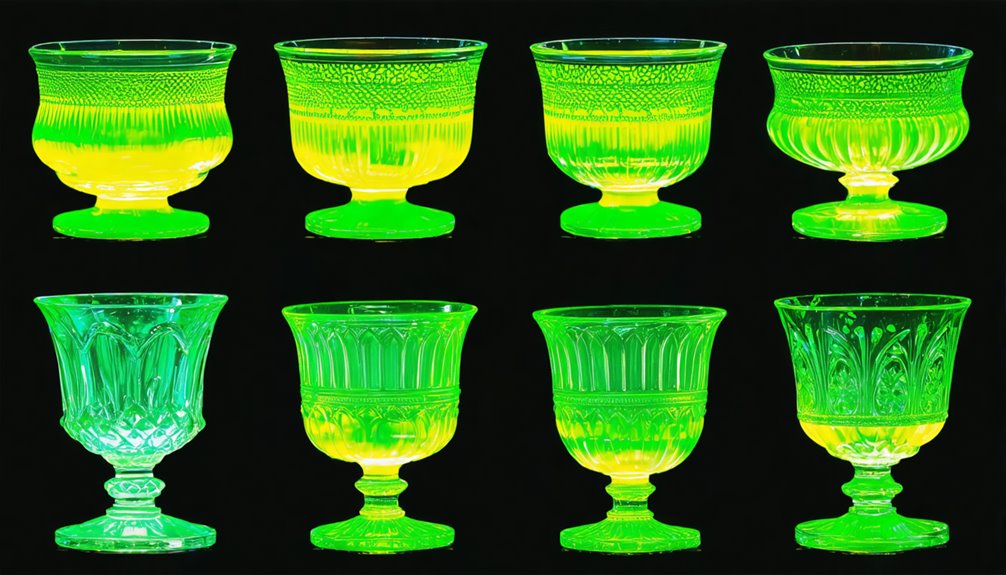
Electron Energy Levels
Uranium glass has a rich history that dates back to the early 19th century. This unique glass, infused with uranium, caught the eye of artisans and chemists alike. Initially, it was used in small decorative items, like vases and bowls. The distinct green color and fluorescent properties made it a favorite among collectors.
In the early days, uranium glass was often used to create beautiful pieces for the dining table. People admired the way it glowed under sunlight. It was seen as a luxury item, showcasing craftsmanship and creativity. The glass also gained popularity in the production of tableware during the Victorian era.
As time went on, scientists discovered uranium’s radioactive properties. This raised concerns about safety, especially with the use of uranium in everyday items. However, the glow under ultraviolet light continued to fascinate many. Collectors began to seek out uranium glass, drawn by its vibrant fluorescence and unique history.
Today, uranium glass is appreciated not only for its beauty but also for its place in the history of glassmaking. It tells a story of innovation and artistry, while also reminding us of the importance of safety in materials we use.
Collectors and historians alike value these pieces for their charm and historical significance.
UV Light Interaction
Uranium glass has a rich history that dates back to the early 19th century. Initially, glassmakers added uranium oxide to create an appealing green color. This practice began in the 1830s. The glass was popular for making decorative items like vases and tableware. People enjoyed its unique hue and shine.
Later, in the late 1800s, scientists discovered a remarkable property of uranium glass: fluorescence. When exposed to ultraviolet (UV) light, uranium glass emits a bright green glow. This glow occurs because the uranium atoms absorb energy from the UV light. The electrons jump to higher energy levels and then fall back, releasing energy as visible light.
The intensity of this fluorescence varies based on the amount of uranium oxide in the glass. Here’s a breakdown of how the concentration affects the glow:
| Uranium Oxide (%) | Fluorescence Intensity | Color Emitted |
|---|---|---|
| 1 to 2% | Moderate | Green |
| 2 to 10% | High | Bright Green |
| Above 10% | Very High | Intense Green |
Collectors and enthusiasts appreciate these glowing pieces. The fascination ties back to both science and history. Uranium glass serves as a bridge, connecting people with the past and sparking interest in the science behind its creation. The vibrant glow is not just beautiful; it tells a story of innovation and curiosity.
Physics of Electron Transitions and Photon Emission
Uranium glass, also known as Vaseline glass, has a fascinating history. It became popular in the late 19th century. People used it for decorative items like dishes and vases. The glass had a unique yellow-green color due to the addition of uranium. This made it stand out and capture attention.
Early on, manufacturers appreciated the glass for its ability to fluoresce under ultraviolet light. The glow was captivating. It drew in collectors and everyday users alike. The glassware was often produced in the United States and Europe. Many artisans created beautiful pieces that showcased intricate designs.
During the 20th century, uranium glass found its way into everyday household items. It was common in kitchens and dining rooms. People enjoyed its quirky charm.
However, after World War II, the popularity of uranium glass began to wane. Concerns about radiation emerged. Although the levels were low, people became wary.
Despite this decline, collectors still seek out uranium glass today. The vintage appeal and historical significance keep it alive. Many admire its aesthetic qualities and unique glow under black light.
In a way, uranium glass tells a story of innovation and changing attitudes towards materials. It remains a curious chapter in the history of glassmaking.
Photon Energy Levels
Uranium glass, also known as Vaseline glass, has a fascinating history. People first started making it in the mid-19th century. Its unique greenish-yellow hue comes from the uranium content. Early glassmakers were drawn to uranium because of its ability to fluoresce under ultraviolet light. This made uranium glass a popular choice for decorative items.
In the Victorian era, uranium glass was used for tableware and ornaments. It caught the eye of collectors and became a trendy item. The glass glowed brightly under UV light, adding an element of surprise and wonder. People enjoyed showing off their glowing pieces at parties.
The manufacturing process involved adding uranium oxide to the glass mix. This process was relatively simple and allowed for vivid colors. Glassmakers learned how to manipulate the uranium content to create stronger fluorescence. The more uranium added, the brighter the glow. This captivated consumers and fueled demand.
However, the rise of health concerns about uranium led to a decline in its popularity. By the mid-20th century, many manufacturers moved away from using uranium in glass. Today, collectors seek out these vintage pieces for their beauty and historical significance.
Uranium glass serves as a reminder of a time when science and artistry intertwined. Its vibrant glow continues to fascinate people. Understanding its history helps us appreciate both the craftsmanship and the science behind this remarkable material.
Electron Excitation Process
Uranium glass has a rich history that dates back to the 1830s. Early glassmakers discovered that adding uranium to glass could create a striking yellow-green color. They enjoyed this vibrant hue and started using uranium to enhance decorative glassware.
At first, uranium glass was primarily a novelty item. It caught the eye of collectors and was popular in household items like vases and bowls. People were fascinated by how this glass would glow under ultraviolet light. This unique property made it a sought-after addition to many homes.
Over time, uranium glass also found its way into industrial applications. Scientists appreciated its fluorescent qualities, which aided in various experiments. The glass was widely used in laboratories, helping researchers study the properties of light and energy.
Despite its appeal, the use of uranium in glass raised health concerns in later years. As awareness of radiation grew, manufacturers gradually moved away from uranium glass.
Today, it’s mostly a collector’s item, with enthusiasts valuing its beauty and historical significance.
Light Emission Mechanism
Uranium glass, also known as Vaseline glass, has a rich history that dates back to the 1830s. Early artisans discovered that adding uranium oxide to glass created a unique luminescent effect. This captivating glow came from the way uranium interacted with light. It became popular in the late 19th century during the Art Nouveau movement. People loved its vibrant greenish hue and the way it sparkled under ultraviolet light.
In the beginning, uranium glass served practical purposes. It was used in everyday items like tableware and decorative pieces. The glow made it a favorite among collectors. Many believed it had healing properties, which added to its allure. However, the excitement wasn’t just about aesthetics; there was also a scientific curiosity. Scientists explored the fluorescence of uranium glass, seeking to understand the light emission mechanism.
As the years went by, the popularity of uranium glass fluctuated. By the mid-20th century, concerns about radiation emerged. Despite this, collectors and enthusiasts continued to value these pieces. The unique characteristics of uranium glass, especially the way it glows under UV light, keep its legacy alive.
Today, uranium glass is a sought-after collectible. It stands as a symbol of innovation in glassmaking and reflects the early fascination with radioactivity. People appreciate not just its beauty but also the historical context surrounding its creation and use.
Mechanisms Behind UV-Induced Luminescence
Uranium glass, also known as Vaseline glass, has a fascinating history. It was popular in the late 19th and early 20th centuries. This unique glass contains uranium oxide, which gives it its distinctive properties. People used it in various items, from decorative pieces to everyday tableware.
Early manufacturers discovered that adding uranium to glass made it glow under ultraviolet (UV) light. This glow comes from the way uranium atoms interact with light. When UV light hits the glass, uranium atoms absorb energy. Electrons within these atoms jump to higher energy levels. Then, they quickly return to their original state, releasing energy in the form of visible light. This process is known as fluorescence.
Many households enjoyed uranium glass for its vibrant colors and charming glow. It became a popular choice for dishes, vases, and other decorative items. However, as awareness of radiation increased, the popularity of uranium glass declined.
Today, collectors appreciate it for its historical value and unique beauty.
Factors Influencing Brightness and Color
Uranium glass has a fascinating history. Its early uses date back to the 1830s when glassmakers discovered that adding uranium oxide to glass created a unique glowing effect. This property of fluorescence made uranium glass highly sought after for decorative items.
Uranium glass became prized in the 1830s for the captivating fluorescent glow achieved by adding uranium oxide, transforming decorative glassmaking.
The amount of uranium oxide in glass could vary. Some pieces had as little as 1% uranium, while others contained up to 25%. More uranium meant a brighter glow. Glassmakers experimented with different oxidation states of uranium and mixed in other metal ions. This experimentation led to a range of colors, from pale yellowish-green to deeper greens.
Different glass recipes were developed over time. Some popular types include Vaseline glass and custard glass. Each recipe had its own unique combination of oxides and colorants, making certain pieces collectible.
Production methods also played a significant role in the final look of the glass. Each manufacturer had its own techniques, which influenced the brightness and color of the finished product. Collectors often prize these differences, as they reflect the craftsmanship and creativity of the glassmakers.
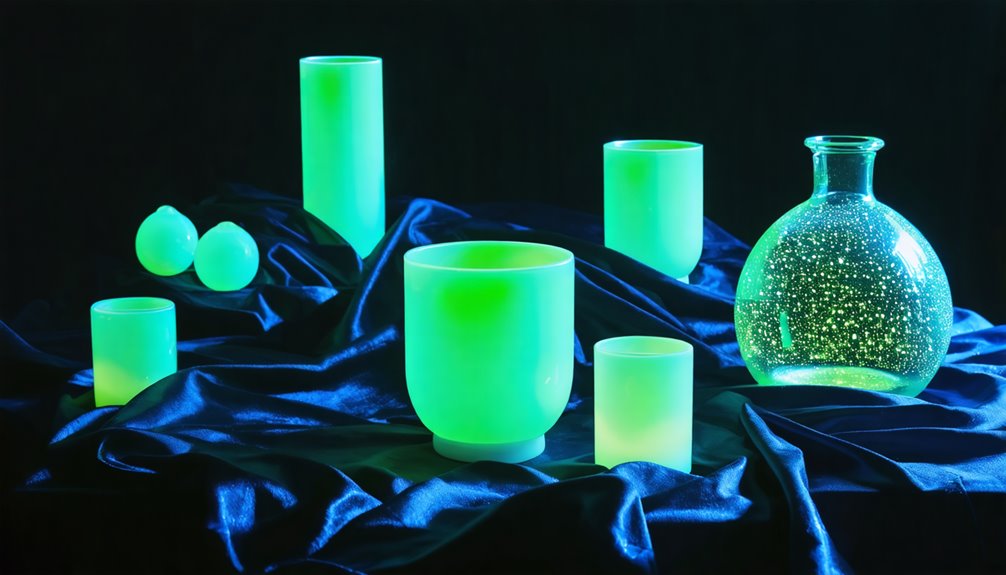
Radiation and Safety Considerations
Uranium glass has a fascinating history. It dates back to the early 19th century, when glassmakers began experimenting with uranium oxide. This unique ingredient gave the glass a distinctive green or yellow color. Early uses of uranium glass included decorative items, tableware, and even some art pieces.
In the late 1800s, uranium glass became popular in the United States and Europe. People admired its vibrant appearance and the way it glowed under ultraviolet light. This glow came from the radiation emitted by the uranium. However, the amount of uranium oxide in the glass was usually low, often around 2%.
Despite its radioactive content, handling uranium glass was generally considered safe. The radiation mainly consists of alpha particles, which can’t penetrate human skin. Still, it’s wise to take precautions. It’s best to avoid prolonged contact with the glass and to wash your hands after handling it.
Many collectors store their pieces in dark places to protect them from UV light. Uranium glass doesn’t require special licensing if it contains less than 10% uranium oxide. This makes it easier for collectors to own these intriguing items.
When buying uranium glass, it’s important to choose reputable sellers. This ensures that the products meet safety standards and are safe to own.
Modern Applications and Collector Interest
Uranium glass has a fascinating history. It was first created in the 1830s. Glassmakers discovered that adding uranium oxide to glass produced a stunning green hue and made the glass glow under ultraviolet light. This unique feature caught the attention of many, leading to its widespread use in decorative items, tableware, and even art pieces.
In the late 19th century, uranium glass became popular in Victorian households. People loved its vibrant color and the way it sparkled in sunlight. It was often used for things like vases, bowls, and drinking glasses. Many manufacturers, such as Westmoreland and Boston & Sandwich, made beautiful uranium glass pieces during this time.
After World War II, uranium glass saw a decline in popularity. Concerns about radiation and safety pushed manufacturers to stop producing these items. However, in the 1980s, interest in uranium glass began to rise again. Collectors and enthusiasts started to appreciate its historical value and unique beauty.
Today, modern companies like Fenton and Mosser have revived the production of uranium glass. They create new pieces that appeal to both collectors and decorators. Many people are drawn to the way uranium glass glows under black light, making it a fun addition to any collection.
Collectors often join groups to share their passion for uranium glass. Organizations like Vaseline Glass Collectors, Inc. provide resources and connections for enthusiasts. This community allows collectors to:
- Share stories from vintage markets and auctions.
- Learn how to identify authentic uranium glass.
- Explore creative ways to display their collections.
- Participate in online exchanges to find rare pieces.
Uranium glass has a rich history that continues to captivate people today. Its unique glow and colorful designs make it a cherished treasure for many collectors.
Frequently Asked Questions
What Causes Uranium Glass to Glow?
Uranium glass has a fascinating history. It glows because it contains small amounts of uranium, which is a radioactive element. When exposed to ultraviolet (UV) light, the glass emits a bright green glow. This happens because the uranium interacts with light, causing electrons in the material to become excited and then release energy as visible light.
In the late 19th and early 20th centuries, uranium glass was popular for making decorative items such as vases and tableware. It was often called “Vaseline glass” due to its yellow-green color. People loved its unique appearance, especially when it glowed under UV light.
Collectors today appreciate uranium glass not just for its beauty but also for its historical significance. It represents a time when uranium was seen as a new and exciting material, used in everyday objects. The glow of uranium glass connects collectors to this intriguing past and highlights the blend of art and science.
How to Illuminate Uranium Glass?
Uranium glass has a fascinating history. In the 19th century, glassmakers discovered that adding uranium to glass made it glow under ultraviolet light. This unique quality caught people’s attention. The glass became popular for decorative items and tableware. It was often used in homes and became a trendy choice for collectors.
Early uses of uranium glass date back to the 1830s. The glass was prized not just for its glow but also for its striking green or yellow hue. Many people enjoyed using it for everyday items like vases and bowls. The glowing effect added a magical touch to ordinary life.
Safety was a concern, but the levels of radiation in uranium glass were quite low. As a result, it was generally considered safe for use. This made it even more appealing to consumers. Over the years, uranium glass has become a collectible item. Many enthusiasts love to display it in their homes.
Today, collectors often use ultraviolet light to showcase their uranium glass. The glow is mesmerizing, and it brings a sense of wonder. It is essential to use caution while handling these items. Knowing the history adds depth to the enjoyment of these beautiful pieces.
Why Is Uranium Glass Illegal?
Uranium glass, also known as Vaseline glass, has a unique history. It first appeared in the early 19th century. Glassmakers added uranium to glass to create a vibrant green or yellow hue. The glass glows under ultraviolet light, which fascinated many.
In the past, uranium glass was popular for tableware and decorative items. People loved its beauty and the way it shimmered. Some believed it had health benefits, thinking the uranium made the glass more durable. However, this belief was not scientifically supported.
Over time, scientists discovered that uranium emits radiation. This led to concerns about safety. The amount of uranium in the glass is usually low. Still, the potential health risks made some governments place restrictions on its sale and ownership.
Today, uranium glass is still legal in many places, but it’s often regulated. Collectors appreciate its historical value. They enjoy understanding its place in the world of glassmaking. This glass tells a story of creativity and caution.
What Is the Chemistry of Uranium Glass?
Uranium glass has a rich history that dates back to the 1830s. Early glassmakers discovered that adding uranium compounds gave glass a vibrant green or yellow hue. This unique coloration made uranium glass popular among collectors and artists.
The initial use of uranium in glass was not motivated by its radioactivity. Instead, artisans valued its aesthetic qualities. They created stunning pieces that could glow under ultraviolet light, captivating people’s interest. This glow is due to the fluorescence of uranium, which adds to the charm of these collectibles.
Safety concerns about radioactivity in uranium glass arose later. However, studies show that the levels of radioactivity in these items are quite low. Collectors can display their pieces without fear of harm. In fact, uranium glass remains a favorite for many due to its intriguing history and striking appearance.
As the popularity of uranium glass grew, it found its way into everyday items like tableware and decorative objects. The mid-20th century saw a boom in production, partly due to the novelty of radioactive materials. Today, uranium glass is cherished by enthusiasts and historians alike, as it reflects a fascinating intersection of art and science.
Conclusion
Uranium glass, also known as Vaseline glass, has a rich history that dates back to the 1830s. Early glassmakers discovered that adding uranium oxide to glass created a unique greenish hue and a remarkable glow under ultraviolet light. This discovery was not just for aesthetics; the glass also had practical uses.
In the late 19th and early 20th centuries, uranium glass became popular for household items. People loved the way it illuminated under black light. It was used in everything from decorative dishes to lamp bases. The glass was often marketed as a novelty item, capturing the interest of collectors and everyday users alike.
During World War II, uranium glass took on a new role. The uranium used in glass was a byproduct of the Manhattan Project. Manufacturers continued to produce uranium glass due to its popularity, even though the radiation levels were low and deemed safe for everyday use. This glass became a symbol of the era, blending science and art in a fascinating way.
Today, uranium glass is cherished by collectors. Its vibrant glow and historical significance make it a sought-after item. Understanding its early uses adds to our appreciation of this unique glass. It tells a story of creativity, innovation, and the intersection of science and beauty in common objects.
